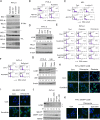Mechanisms for mTORC1 activation and synergistic induction of apoptosis by ruxolitinib and BH3 mimetics or autophagy inhibitors in JAK2-V617F-expressing leukemic cells including newly established PVTL-2
- PMID: 29928488
- PMCID: PMC6003557
- DOI: 10.18632/oncotarget.25515
Mechanisms for mTORC1 activation and synergistic induction of apoptosis by ruxolitinib and BH3 mimetics or autophagy inhibitors in JAK2-V617F-expressing leukemic cells including newly established PVTL-2
Abstract
The activated JAK2-V617F mutant is very frequently found in myeloproliferative neoplasms (MPNs), and its inhibitor ruxolitinib has been in clinical use, albeit with limited efficacies. Here, we examine the signaling mechanisms from JAK2-V617F and responses to ruxolitinib in JAK2-V617F-positive leukemic cell lines, including PVTL-2, newly established from a patient with post-MPN secondary acute myeloid leukemia, and the widely used model cell line HEL. We have found that ruxolitinib downregulated the mTORC1/S6K/4EBP1 pathway at least partly through inhibition of the STAT5/Pim-2 pathway with concomitant downregulation of c-Myc, MCL-1, and BCL-xL as well as induction of autophagy in these cells. Ruxolitinib very efficiently inhibited proliferation but only modestly induced apoptosis. However, inhibition of BCL-xL/BCL-2 by the BH3 mimetics ABT-737 and navitoclax or BCL-xL by A-1331852 induced caspase-dependent apoptosis involving activation of Bak and Bax synergistically with ruxolitinib in HEL cells. On the other hand, the putative pan-BH3 mimetic obatoclax as well as chloroquine and bafilomycin A1 inhibited autophagy at its late stage and induced apoptosis in PVTL-2 cells synergistically with ruxolitinib. The present study suggests that autophagy as well as the anti-apoptotic BCL-2 family members, regulated at least partly by the mTORC1 pathway downstream of STAT5/Pim-2, protects JAK2-V617F-positive leukemic cells from ruxolitinib-induced apoptosis depending on cell types and may contribute to development of new strategies against JAK2-V617F-positive neoplasms.
Keywords: BH3 mimetic; JAK2-V617F; MPN; apoptosis; mTOR.
Conflict of interest statement
CONFLICTS OF INTEREST The authors declare no conflicts of interest.
Figures






Similar articles
-
Inhibition of USP9X Downregulates JAK2-V617F and Induces Apoptosis Synergistically with BH3 Mimetics Preferentially in Ruxolitinib-Persistent JAK2-V617F-Positive Leukemic Cells.Cancers (Basel). 2020 Feb 10;12(2):406. doi: 10.3390/cancers12020406. Cancers (Basel). 2020. PMID: 32050632 Free PMC article.
-
Proliferation and survival signaling from both Jak2-V617F and Lyn involving GSK3 and mTOR/p70S6K/4EBP1 in PVTL-1 cell line newly established from acute myeloid leukemia transformed from polycythemia vera.PLoS One. 2014 Jan 3;9(1):e84746. doi: 10.1371/journal.pone.0084746. eCollection 2014. PLoS One. 2014. PMID: 24404189 Free PMC article.
-
The PIM inhibitor AZD1208 synergizes with ruxolitinib to induce apoptosis of ruxolitinib sensitive and resistant JAK2-V617F-driven cells and inhibit colony formation of primary MPN cells.Oncotarget. 2015 Nov 24;6(37):40141-57. doi: 10.18632/oncotarget.5653. Oncotarget. 2015. PMID: 26472029 Free PMC article.
-
JAK2 in pediatric leukemia: mechanisms of pathogenesis and drug development - a narrative review.Ann Med Surg (Lond). 2025 Mar 18;87(6):3410-3423. doi: 10.1097/MS9.0000000000003180. eCollection 2025 Jun. Ann Med Surg (Lond). 2025. PMID: 40486651 Free PMC article. Review.
-
Mechanisms Underlying the Anti-inflammatory and Immunosuppressive Activity of Ruxolitinib.Front Oncol. 2019 Nov 7;9:1186. doi: 10.3389/fonc.2019.01186. eCollection 2019. Front Oncol. 2019. PMID: 31788449 Free PMC article. Review.
Cited by
-
The potential of proliferative and apoptotic parameters in clinical flow cytometry of myeloid malignancies.Blood Adv. 2021 Apr 13;5(7):2040-2052. doi: 10.1182/bloodadvances.2020004094. Blood Adv. 2021. PMID: 33847740 Free PMC article. Review.
-
Ruxolitinib-loaded poly-ɛ-caprolactone (PCL) nanoparticles inhibit JAK2/STAT5 signaling in BT474 breast cancer cells by downregulating Bcl-2 and Mcl-1.Mol Biol Rep. 2024 Jul 22;51(1):832. doi: 10.1007/s11033-024-09764-3. Mol Biol Rep. 2024. PMID: 39037638
-
Dibenzo [a, c] phenazin-11-yl(phenyl) methanone (SBLJ23), a novel selective inhibitor targeting JAK2V617F mutation in myeloproliferative neoplasms.Oncol Res. 2025 Feb 28;33(3):675-685. doi: 10.32604/or.2024.056256. eCollection 2025. Oncol Res. 2025. PMID: 40109858 Free PMC article.
-
Somatically acquired mutations in primary myelofibrosis: A case report and meta-analysis.Exp Ther Med. 2021 Mar;21(3):193. doi: 10.3892/etm.2021.9625. Epub 2021 Jan 7. Exp Ther Med. 2021. PMID: 33488802 Free PMC article.
-
Finding a Jill for JAK: Assessing Past, Present, and Future JAK Inhibitor Combination Approaches in Myelofibrosis.Cancers (Basel). 2020 Aug 14;12(8):2278. doi: 10.3390/cancers12082278. Cancers (Basel). 2020. PMID: 32823910 Free PMC article. Review.
References
-
- Springuel L, Renauld JC, Knoops L. JAK kinase targeting in hematologic malignancies: a sinuous pathway from identification of genetic alterations towards clinical indications. Haematologica. 2015;100:1240–1253. https://doi.org/10.3324/haematol.2015.132142. - DOI - PMC - PubMed
-
- Ihle JN, Gilliland DG. Jak2: normal function and role in hematopoietic disorders. Curr Opin Genet Dev. 2007;17:8–14. https://doi.org/10.1016/j.gde.2006.12.009. - DOI - PubMed
-
- Spivak JL. Myeloproliferative Neoplasms. N Engl J Med. 2017;376:2168–2181. https://doi.org/10.1056/NEJMra1406186. - DOI - PubMed
-
- Bose P, Verstovsek S. JAK2 inhibitors for myeloproliferative neoplasms: what is next? Blood. 2017;130:115–125. https://doi.org/10.1182/blood-2017-04-742288. - DOI - PMC - PubMed
-
- Quentmeier H, MacLeod RA, Zaborski M, Drexler HG. JAK2 V617F tyrosine kinase mutation in cell lines derived from myeloproliferative disorders. Leukemia. 2006;20:471–476. https://doi.org/10.1038/sj.leu.2404081. - DOI - PubMed
LinkOut - more resources
Full Text Sources
Other Literature Sources
Research Materials
Miscellaneous

